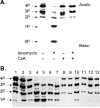Identification of calcineurin regulated phosphorylation sites on CRHSP-24
- PMID: 19477163
- PMCID: PMC2740617
- DOI: 10.1016/j.bbrc.2009.05.096
Identification of calcineurin regulated phosphorylation sites on CRHSP-24
Abstract
CRHSP-24 is a prominently regulated phosphoprotein in pancreatic acinar cells where it is the major substrate for the serine/threonine protein phosphatase, calcineurin, in response to secretagogues. We now identify the four regulated sites of CRHSP-24 phosphorylation as serines 30, 32, 41, and 52 and show that Ser(30) and Ser(32) are directly dephosphorylated by calcineurin. Coordinate phosphorylation/dephosphorylation of these four serines explains the multiple phosphorylated isoforms of CRHSP-24 present in acinar cells and provides a molecular framework to study CRHSP-24 regulation by secretagogues and growth factor-induced kinases and phosphatases in vivo.
Figures




Similar articles
-
Structure-functional analyses of CRHSP-24 plasticity and dynamics in oxidative stress response.J Biol Chem. 2011 Mar 18;286(11):9623-35. doi: 10.1074/jbc.M110.177436. Epub 2010 Dec 22. J Biol Chem. 2011. PMID: 21177848 Free PMC article.
-
Purification and characterization of a novel physiological substrate for calcineurin in mammalian cells.J Biol Chem. 1998 Aug 28;273(35):22738-44. doi: 10.1074/jbc.273.35.22738. J Biol Chem. 1998. PMID: 9712905
-
CRHSP-24 phosphorylation is regulated by multiple signaling pathways in pancreatic acinar cells.Am J Physiol Gastrointest Liver Physiol. 2003 Oct;285(4):G726-34. doi: 10.1152/ajpgi.00111.2003. Epub 2003 Jun 11. Am J Physiol Gastrointest Liver Physiol. 2003. PMID: 12801884
-
Purification and identification of a 28-kDa calcium-regulated heat-stable protein. A novel secretagogue-regulated phosphoprotein in exocrine pancreas.J Biol Chem. 1996 Dec 6;271(49):31502-7. doi: 10.1074/jbc.271.49.31502. J Biol Chem. 1996. PMID: 8940165
-
Flicking the switches: phosphorylation of serine/threonine protein phosphatases.Semin Cancer Biol. 1995 Aug;6(4):211-7. doi: 10.1006/scbi.1995.0028. Semin Cancer Biol. 1995. PMID: 8541516 Review.
Cited by
-
Heterodimerization of β2 adrenergic receptor and somatostatin receptor 5: Implications in modulation of signaling pathway.J Mol Signal. 2011 Aug 12;6:9. doi: 10.1186/1750-2187-6-9. J Mol Signal. 2011. PMID: 21838893 Free PMC article.
-
Genome-wide CRISPR/Cas9 screening identifies CARHSP1 responsible for radiation resistance in glioblastoma.Cell Death Dis. 2021 Jul 21;12(8):724. doi: 10.1038/s41419-021-04000-3. Cell Death Dis. 2021. PMID: 34290231 Free PMC article.
-
The RNA binding protein CARHSP1 facilitates tumor growth, metastasis and immune escape by enhancing IL-17RA mRNA stabilization in prostate cancer.Cell Biosci. 2025 Mar 7;15(1):33. doi: 10.1186/s13578-025-01371-4. Cell Biosci. 2025. PMID: 40055805 Free PMC article.
-
Inhibition of gluconeogenic genes by calcium-regulated heat-stable protein 1 via repression of peroxisome proliferator-activated receptor α.J Biol Chem. 2011 Nov 25;286(47):40584-94. doi: 10.1074/jbc.M111.232918. Epub 2011 Oct 11. J Biol Chem. 2011. PMID: 21990353 Free PMC article.
-
Structure-functional analyses of CRHSP-24 plasticity and dynamics in oxidative stress response.J Biol Chem. 2011 Mar 18;286(11):9623-35. doi: 10.1074/jbc.M110.177436. Epub 2010 Dec 22. J Biol Chem. 2011. PMID: 21177848 Free PMC article.
References
-
- Groblewski GE, Wagner AC, Williams JA. Cyclosporin A inhibits Ca2+/calmodulin-dependent protein phosphatase and secretion in pancreatic acinar cells. J Biol Chem. 1994;269:15111–15117. - PubMed
-
- Groblewski GE, Yoshida M, Bragado MJ, Ernst SA, Leykam J, Williams JA. Purification and characterization of a novel physiological substrate for calcineurin in mammalian cells. J Biol Chem. 1998;273:22738–22744. - PubMed
-
- Castiglia D, Scaturro M, Nastasi T, Cestelli A, Di Liegro I. PIPPin, a putative RNA-binding protein specifically expressed in the rat brain. Biochem Biophys Res Commun. 1996;218:390–394. - PubMed
-
- Nastasi T, Scaturro M, Bellafiore M, Raimondi L, Beccari S, Cestelli A, di Liegro I. PIPPin is a brain-specific protein that contains a cold-shock domain and binds specifically to H1 degrees and H3.3 mRNAs. J Biol Chem. 1999;274:24087–24093. - PubMed
Publication types
MeSH terms
Substances
Grants and funding
LinkOut - more resources
Full Text Sources
Molecular Biology Databases

